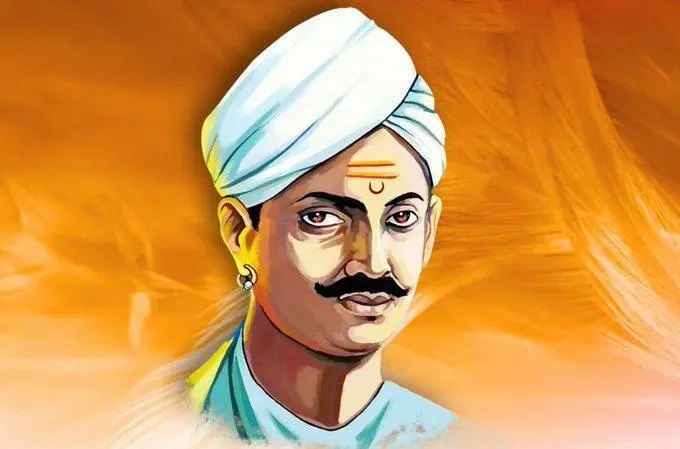Mangal Pandey – the Indian Infantryman who fired the first shot of the Indian Rebellion of 1857

Mangal Pandey served in the 34th Regiment of the Bengal Native Infantry. Image: A 1984 Indian stamp depicting Mangal Pandey, the first Indian soldier to aim his loaded weapon at a British officer in 1856
In the years after the horrific Indian Revolt of 1857, the British came out with the derogatory name “Pandee” or “Pandey” to describe a mutinous sepoy (i.e. an Indian infantryman). But to mutinous sepoys during the Rebellion, Indian infantryman Mangal Pandey was seen as a hero: the first sepoy to fire a loaded gun at a British officer in the lead up to the Indian Revolt. But what motivated Pandey to take such a drastic move, and just how did he feel about that action later during his court martial?
Below, everything you ever wanted to know about the 29-year-old infantryman and his famed action of March 29, 1857.
The 34th Regiment of the Bengal Native Infantry
Typical of many sepoys of the Bengal Army, Pandey hailed from a Hindu Brahmin family. He is said to have joined the Bengal Army in 1849. He served in the 5th Company of the 34th Regiment of the Bengal Native Infantry (BNI).
The Bengal Native Infantry was part of the larger Bengal Army, which in turn was one of three armies of the British East India Company (BEIC). Beginning around 1757, the behemoth of trading company had began ruling the Indian subcontinent and other parts of Southeast Asia. Known as the army of the Bengal Presidency, the Bengal Army was undoubtedly the largest of the three armies of the BEIC. The army could boast of having more than 70 regiments as at 1857. The other two were the Bombay Army and Madras Army, which had 24 and 52 regiments, respectively.
the British East India Company (EIC), a gargantuan trade company that began ruling large parts of the Indian subcontinent in the mid-18th century. At some point in time, the company accounted for about half of the world’s trade. Image: Flag of the British East India Company
March 29, 1857: “come out – the Europeans are here”
On the day of the incident, March 29, Pandey stormed out of his room in a very erratic manner, almost like someone who was in a religious frenzy. He appeared very out of control and started dishing out threats to British officers of the Bengal Army, accusing them of trying to defile his religion and culture. The young Indian infantryman was obviously referring to the animal fat smeared cartridges of the weapon that the BEIC had recently introduced.
Pandey called out his colleagues to join him and resist the British officers, stating, “come out – the Europeans are here”. After issuing out a number of threats, he then proceeded to stalk a British officer by the name of Lieutenant Baugh, an Adjutant of the 34th Bengal Native Infantry. Luckily for Baugh, Pandey missed his shot as the bullet struck Baugh’s horse. Baugh picked himself up and returned fire, but he too missed. Pandey then charged at Baugh with a heavy Indian sword called talwar. The assailant struck the British officer with such ferocity, delivering heavy slices on the shoulder and neck.
Pandey later stated that he was high on a narcotic substance called bhang on March 29. The Indian soldier was incensed by the British East Indian Company’s decision to use animal fat that contained pig fat and cow fat in the manufacture of cartridges of the soldiers’ rifles.
Just as Pandey was about to deliver what could most likely have been the lethal strike, one of his colleagues, Shaikh Paltu, intervened and restrained the irate Indian soldier. Other sepoys simply stood there and watched the event unfold; some of them even threatened to shoot Paltu if he did not let go of Pandey.
As the ruckus got even louder, British Sergeant-Major Hewson arrived on the scene. Hewson quickly ordered a quarter guard by the name of Jemadar Ishwari Prasad to arrest Pandey. Prasad refused to comply with Hewson’s orders. It was only when General John Hearsey, the commanding officer, arrived on the scene that calm finally prevailed. Hearsey ordered the men to stand down and arrest Pandey. The general threatened to shoot anyone who refused to comply with his orders. It was in that moment that Pandey directed his weapon at himself and fired. It appeared Pandey was trying to commit suicide. He was only mortally wounded.
The Enfield rifle proved to be very unpopular among Indian troops as the cartridges had pig and cow fat on them. Image: Pattern 1853 Enfield rifled musket.
Court Martial and Death Sentence
After recovering about a week later, Pandey was court-martialled, found guilty, and slapped with a death sentence. During his trial, he maintained that no one else was in on his mutinous action. He also told the panel that on the day of the incident he had taking copious amounts of the narcotic substance bhang.
Pandey’s death sentence was carried out on April 6. He was hanged.
And as for the Prasad – the officer who refused to arrest Pandey – the court found him guilty of mutiny. Prasad was executed on April 21.
Paltu, the only officer that tried to restrain Pandey, was rewarded with a promotion to sergeant (havildar). Fuming over the disbandment of their regiment, some sepoys saw Paltu as a traitor. Less than a week later, Paltu was killed by his former colleagues.
The 34th Regiment gets disbanded
Following the incident and subsequent investigations, the BIEC disbanded the 34th regiment “with disgrace” on 6th May. The reasons for collective punishment of the regiment was that the officers on the scene failed to restrain a mutinous soldier. The regiment was therefore seen as unreliable.
The last straw that broke the camel’s back
Many sepoys at the time considered the punishment meted out to the 34th Regiment too harsh. This explains why the event in many ways served as the catalyst for the nationwide rebellion (i.e. the Indian Rebellion of 1857) that broke out a few months later.
The 1857 Indian Rebellion
Other interesting facts
The Mangal Pandey cenotaph at Barrackpore Cantonment, West Bengal.
- During his court martial, Pandey claimed that he was high on bhang (a narcotic substance) and opium. He said that he was not conscious of his actions on March 29.
- It is said that many members of the later Indian Nationalist Movement took some bit of inspiration from Pandey’s mutinous action.
- On October 5, 1984, the Indian government issued a postage stamp, which was designed by Indian artist C.R. Pakrashi, to commemorate Mangal Pandey and his action on that faithful day.
- Park at the Barrakpore Cantonment in West Bengal was built to honor Pandey. It’s said that the location of the park is where Pandey mutinied.
ಮಂಗಲ್ ಪಾಂಡೆ – 1857 ರ ಭಾರತೀಯ ದಂಗೆಯ ಮೊದಲ ಗುಂಡು ಹಾರಿಸಿದ ಭಾರತೀಯ ಪದಾತಿ ದಳ:
ಮಂಗಲ್ ಪಾಂಡೆ ಅವರು ಬಂಗಾಳ ಸ್ಥಳೀಯ ಪದಾತಿ ದಳದ 34 ನೇ ರೆಜಿಮೆಂಟ್ನಲ್ಲಿ ಸೇವೆ ಸಲ್ಲಿಸಿದರು. ಚಿತ್ರ: 1984 ರ ಭಾರತೀಯ ಅಂಚೆಚೀಟಿ ಮಂಗಲ್ ಪಾಂಡೆ, 1856 ರಲ್ಲಿ ಬ್ರಿಟೀಷ್ ಅಧಿಕಾರಿಯ ಮೇಲೆ ತನ್ನ ಲೋಡ್ ಮಾಡಿದ ಶಸ್ತ್ರಾಸ್ತ್ರವನ್ನು ಗುರಿಯಿಟ್ಟುಕೊಂಡ ಮೊದಲ ಭಾರತೀಯ ಸೈನಿಕ
1857 ರ ಭೀಕರ ಭಾರತೀಯ ದಂಗೆಯ ನಂತರದ ವರ್ಷಗಳಲ್ಲಿ, ಬ್ರಿಟಿಷರು ದಂಗೆಕೋರ ಸಿಪಾಯಿಯನ್ನು (ಅಂದರೆ ಭಾರತೀಯ ಕಾಲಾಳುಪಡೆ) ವಿವರಿಸಲು “ಪಾಂಡಿ” ಅಥವಾ “ಪಾಂಡೆ” ಎಂಬ ಅವಹೇಳನಕಾರಿ ಹೆಸರನ್ನು ಹೊರತಂದರು. ಆದರೆ ದಂಗೆಯ ಸಮಯದಲ್ಲಿ ದಂಗೆಯೆದ್ದ ಸಿಪಾಯಿಗಳಿಗೆ, ಭಾರತೀಯ ಪದಾತಿ ದಳದ ಮಂಗಲ್ ಪಾಂಡೆ ಹೀರೋ ಆಗಿ ಕಾಣಿಸಿಕೊಂಡರು: ಭಾರತೀಯ ದಂಗೆಗೆ ಮುನ್ನ ಬ್ರಿಟಿಷ್ ಅಧಿಕಾರಿಯ ಮೇಲೆ ತುಂಬಿದ ಬಂದೂಕಿನಿಂದ ಗುಂಡು ಹಾರಿಸಿದ ಮೊದಲ ಸಿಪಾಯಿ. ಆದರೆ ಅಂತಹ ಕಠಿಣ ಕ್ರಮವನ್ನು ತೆಗೆದುಕೊಳ್ಳಲು ಪಾಂಡೆಯನ್ನು ಯಾವುದು ಪ್ರೇರೇಪಿಸಿತು ಮತ್ತು ನಂತರ ಅವರ ಕೋರ್ಟ್ ಮಾರ್ಷಲ್ ಸಮಯದಲ್ಲಿ ಆ ಕ್ರಮದ ಬಗ್ಗೆ ಅವನಿಗೆ ಹೇಗೆ ಅನಿಸಿತು?
ಕೆಳಗೆ, ನೀವು 29 ವರ್ಷದ ಪದಾತಿ ದಳದ ಬಗ್ಗೆ ಮತ್ತು ಮಾರ್ಚ್ 29, 1857 ರ ಅವನ ಪ್ರಸಿದ್ಧ ಕ್ರಿಯೆಯ ಬಗ್ಗೆ ತಿಳಿದುಕೊಳ್ಳಲು ಬಯಸಿದ ಎಲ್ಲವೂ.
ಬಂಗಾಳ ಸ್ಥಳೀಯ ಪದಾತಿ ದಳದ 34ನೇ ರೆಜಿಮೆಂಟ್
ಬಂಗಾಳದ ಸೇನೆಯ ಅನೇಕ ಸಿಪಾಯಿಗಳಲ್ಲಿ ವಿಶಿಷ್ಟವಾದ ಪಾಂಡೆ ಹಿಂದೂ ಬ್ರಾಹ್ಮಣ ಕುಟುಂಬದಿಂದ ಬಂದವರು. ಅವರು 1849 ರಲ್ಲಿ ಬಂಗಾಳ ಸೇನೆಗೆ ಸೇರಿದರು ಎಂದು ಹೇಳಲಾಗುತ್ತದೆ. ಅವರು ಬಂಗಾಳ ಸ್ಥಳೀಯ ಪದಾತಿಸೈನ್ಯದ (BNI) 34 ನೇ ರೆಜಿಮೆಂಟ್ನ 5 ನೇ ಕಂಪನಿಯಲ್ಲಿ ಸೇವೆ ಸಲ್ಲಿಸಿದರು.
ಬಂಗಾಳ ಸ್ಥಳೀಯ ಪದಾತಿಸೈನ್ಯವು ದೊಡ್ಡ ಬಂಗಾಳದ ಸೈನ್ಯದ ಭಾಗವಾಗಿತ್ತು, ಇದು ಬ್ರಿಟಿಷ್ ಈಸ್ಟ್ ಇಂಡಿಯಾ ಕಂಪನಿಯ (BEIC) ಮೂರು ಸೈನ್ಯಗಳಲ್ಲಿ ಒಂದಾಗಿದೆ. 1757 ರ ಸುಮಾರಿಗೆ, ವ್ಯಾಪಾರ ಕಂಪನಿಯ ಬೆಹೆಮೊತ್ ಭಾರತೀಯ ಉಪಖಂಡ ಮತ್ತು ಆಗ್ನೇಯ ಏಷ್ಯಾದ ಇತರ ಭಾಗಗಳನ್ನು ಆಳಲು ಪ್ರಾರಂಭಿಸಿತು. ಬೆಂಗಾಲ್ ಪ್ರೆಸಿಡೆನ್ಸಿಯ ಸೈನ್ಯ ಎಂದು ಕರೆಯಲ್ಪಡುವ ಬಂಗಾಳದ ಸೈನ್ಯವು BEIC ಯ ಮೂರು ಸೈನ್ಯಗಳಲ್ಲಿ ನಿಸ್ಸಂದೇಹವಾಗಿ ದೊಡ್ಡದಾಗಿದೆ. ಸೈನ್ಯವು 1857 ರಂತೆ 70 ಕ್ಕೂ ಹೆಚ್ಚು ರೆಜಿಮೆಂಟ್ಗಳನ್ನು ಹೊಂದಿದೆ ಎಂದು ಹೆಮ್ಮೆಪಡಬಹುದು. ಇತರ ಎರಡು ಬಾಂಬೆ ಆರ್ಮಿ ಮತ್ತು ಮದ್ರಾಸ್ ಆರ್ಮಿ ಕ್ರಮವಾಗಿ 24 ಮತ್ತು 52 ರೆಜಿಮೆಂಟ್ಗಳನ್ನು ಹೊಂದಿದ್ದವು.
ಬ್ರಿಟಿಷ್ ಈಸ್ಟ್ ಇಂಡಿಯಾ ಕಂಪನಿ (EIC), 18 ನೇ ಶತಮಾನದ ಮಧ್ಯಭಾಗದಲ್ಲಿ ಭಾರತೀಯ ಉಪಖಂಡದ ಹೆಚ್ಚಿನ ಭಾಗಗಳನ್ನು ಆಳಲು ಪ್ರಾರಂಭಿಸಿದ ಒಂದು ಬೃಹತ್ ವ್ಯಾಪಾರ ಕಂಪನಿ. ಕೆಲವು ಸಮಯದಲ್ಲಿ, ಕಂಪನಿಯು ವಿಶ್ವದ ವ್ಯಾಪಾರದ ಅರ್ಧದಷ್ಟು ಭಾಗವನ್ನು ಹೊಂದಿದೆ. ಚಿತ್ರ: ಬ್ರಿಟಿಷ್ ಈಸ್ಟ್ ಇಂಡಿಯಾ ಕಂಪನಿಯ ಧ್ವಜ
ಮಾರ್ಚ್ 29, 1857: “ಹೊರಗೆ ಬನ್ನಿ – ಯುರೋಪಿಯನ್ನರು ಇಲ್ಲಿದ್ದಾರೆ”
ಘಟನೆಯ ದಿನ, ಮಾರ್ಚ್ 29 ರಂದು, ಪಾಂಡೆ ತನ್ನ ಕೋಣೆಯಿಂದ ತುಂಬಾ ಅನಿಯಂತ್ರಿತ ರೀತಿಯಲ್ಲಿ, ಧಾರ್ಮಿಕ ಉನ್ಮಾದದಲ್ಲಿದ್ದವನಂತೆ ಹೊರಗೆ ಬಂದನು. ಅವರು ನಿಯಂತ್ರಣವಿಲ್ಲದೆ ಕಾಣಿಸಿಕೊಂಡರು ಮತ್ತು ಬಂಗಾಳ ಸೇನೆಯ ಬ್ರಿಟಿಷ್ ಅಧಿಕಾರಿಗಳಿಗೆ ಬೆದರಿಕೆಗಳನ್ನು ಹಾಕಲು ಪ್ರಾರಂಭಿಸಿದರು, ಅವರು ತಮ್ಮ ಧರ್ಮ ಮತ್ತು ಸಂಸ್ಕೃತಿಯನ್ನು ಅಪವಿತ್ರಗೊಳಿಸಲು ಪ್ರಯತ್ನಿಸುತ್ತಿದ್ದಾರೆ ಎಂದು ಆರೋಪಿಸಿದರು. ಯುವ ಭಾರತೀಯ ಪದಾತಿ ದಳದವರು BEIC ಇತ್ತೀಚೆಗೆ ಪರಿಚಯಿಸಿದ ಆಯುಧದ ಪ್ರಾಣಿಗಳ ಕೊಬ್ಬನ್ನು ಹೊದಿಸಿದ ಕಾರ್ಟ್ರಿಜ್ಗಳನ್ನು ಸ್ಪಷ್ಟವಾಗಿ ಉಲ್ಲೇಖಿಸುತ್ತಿದ್ದಾರೆ.
ಪಾಂಡೆ ತನ್ನ ಸಹೋದ್ಯೋಗಿಗಳನ್ನು ತನ್ನೊಂದಿಗೆ ಸೇರಲು ಮತ್ತು ಬ್ರಿಟಿಷ್ ಅಧಿಕಾರಿಗಳನ್ನು ವಿರೋಧಿಸಲು ಕರೆದರು, “ಹೊರಗೆ ಬನ್ನಿ – ಯುರೋಪಿಯನ್ನರು ಇಲ್ಲಿದ್ದಾರೆ” ಎಂದು ಹೇಳಿದರು. ಹಲವಾರು ಬೆದರಿಕೆಗಳನ್ನು ನೀಡಿದ ನಂತರ, ಅವರು 34 ನೇ ಬಂಗಾಳ ಸ್ಥಳೀಯ ಪದಾತಿ ದಳದ ಸಹಾಯಕ ಲೆಫ್ಟಿನೆಂಟ್ ಬಾಗ್ ಎಂಬ ಬ್ರಿಟಿಷ್ ಅಧಿಕಾರಿಯನ್ನು ಹಿಂಬಾಲಿಸಲು ಮುಂದಾದರು. ಬಾಗ್ಗೆ ಅದೃಷ್ಟವಶಾತ್, ಬುಲೆಟ್ ಬಾಗ್ನ ಕುದುರೆಗೆ ಬಡಿದಿದ್ದರಿಂದ ಪಾಂಡೆ ತನ್ನ ಹೊಡೆತವನ್ನು ತಪ್ಪಿಸಿಕೊಂಡರು. ಬಾಗ್ ತನ್ನನ್ನು ತಾನೇ ಎತ್ತಿಕೊಂಡು ಬೆಂಕಿಯನ್ನು ಹಿಂದಿರುಗಿಸಿದನು, ಆದರೆ ಅವನೂ ತಪ್ಪಿಸಿಕೊಂಡನು. ಪಾಂಡೆ ನಂತರ ಬಾಗ್ನಲ್ಲಿ ತಲ್ವಾರ್ ಎಂಬ ಭಾರವಾದ ಭಾರತೀಯ ಕತ್ತಿಯಿಂದ ಚಾರ್ಜ್ ಮಾಡಿದರು. ಆಕ್ರಮಣಕಾರನು ಬ್ರಿಟಿಷ್ ಅಧಿಕಾರಿಯನ್ನು ಅಂತಹ ಉಗ್ರತೆಯಿಂದ ಹೊಡೆದನು, ಭುಜ ಮತ್ತು ಕುತ್ತಿಗೆಯ ಮೇಲೆ ಭಾರವಾದ ಚೂರುಗಳನ್ನು ವಿತರಿಸಿದನು.
ಪಾಂಡೆ ಅವರು ಮಾರ್ಚ್ 29 ರಂದು ಭಾಂಗ್ ಎಂಬ ಮಾದಕ ವಸ್ತುವಿನ ಮೇಲೆ ಹೆಚ್ಚು ಎಂದು ಹೇಳಿದರು. ಸೈನಿಕರ ರೈಫಲ್ಗಳ ಕಾರ್ಟ್ರಿಡ್ಜ್ಗಳ ತಯಾರಿಕೆಯಲ್ಲಿ ಹಂದಿ ಕೊಬ್ಬು ಮತ್ತು ಹಸುವಿನ ಕೊಬ್ಬನ್ನು ಒಳಗೊಂಡಿರುವ ಪ್ರಾಣಿಗಳ ಕೊಬ್ಬನ್ನು ಬಳಸುವ ಬ್ರಿಟಿಷ್ ಈಸ್ಟ್ ಇಂಡಿಯನ್ ಕಂಪನಿಯ ನಿರ್ಧಾರದಿಂದ ಭಾರತೀಯ ಸೈನಿಕನು ಕೆರಳಿದನು. .
ಪಾಂಡೆ ಮಾರಣಾಂತಿಕ ಮುಷ್ಕರ ಏನಾಗಬಹುದೋ ಅದನ್ನು ನೀಡಲು ಹೊರಟಿದ್ದಾಗಲೇ, ಅವರ ಸಹೋದ್ಯೋಗಿಗಳಲ್ಲಿ ಒಬ್ಬರಾದ ಶೇಖ್ ಪಲ್ಟು ಅವರು ಮಧ್ಯಪ್ರವೇಶಿಸಿ ಕೋಪಗೊಂಡ ಭಾರತೀಯ ಸೈನಿಕನನ್ನು ತಡೆದರು. ಇತರ ಸಿಪಾಯಿಗಳು ಸುಮ್ಮನೆ ಅಲ್ಲಿಯೇ ನಿಂತು ಘಟನೆ ನಡೆಯುವುದನ್ನು ವೀಕ್ಷಿಸಿದರು; ಅವರಲ್ಲಿ ಕೆಲವರು ಪಾಂಡೆಯನ್ನು ಬಿಡದಿದ್ದರೆ ಪಲ್ಟು ಗುಂಡು ಹಾರಿಸುವುದಾಗಿ ಬೆದರಿಕೆ ಹಾಕಿದರು.
ಗದ್ದಲವು ಇನ್ನಷ್ಟು ಜೋರಾದಾಗ, ಬ್ರಿಟಿಷ್ ಸಾರ್ಜೆಂಟ್-ಮೇಜರ್ ಹ್ಯೂಸನ್ ದೃಶ್ಯಕ್ಕೆ ಬಂದರು. ಪಾಂಡೆಯನ್ನು ಬಂಧಿಸಲು ಜೇಮದರ್ ಈಶ್ವರಿ ಪ್ರಸಾದ್ ಎಂಬ ಹೆಸರಿನ ಕ್ವಾರ್ಟರ್ ಗಾರ್ಡ್ಗೆ ಹ್ಯೂಸನ್ ತ್ವರಿತವಾಗಿ ಆದೇಶಿಸಿದರು. ಪ್ರಸಾದ್ ಹೆವ್ಸನ್ ಅವರ ಆದೇಶಗಳನ್ನು ಅನುಸರಿಸಲು ನಿರಾಕರಿಸಿದರು. ಕಮಾಂಡಿಂಗ್ ಆಫೀಸರ್ ಜನರಲ್ ಜಾನ್ ಹಿಯರ್ಸೆ ಸ್ಥಳಕ್ಕೆ ಬಂದಾಗ ಮಾತ್ರ ಅಂತಿಮವಾಗಿ ಶಾಂತವಾಗಿತ್ತು. ಹಿಯರ್ಸೆ ಅವರು ಕೆಳಗಿಳಿಯಲು ಮತ್ತು ಪಾಂಡೆಯನ್ನು ಬಂಧಿಸಲು ಆದೇಶಿಸಿದರು. ತನ್ನ ಆದೇಶಗಳನ್ನು ಅನುಸರಿಸಲು ನಿರಾಕರಿಸುವ ಯಾರಿಗಾದರೂ ಗುಂಡು ಹಾರಿಸುವುದಾಗಿ ಜನರಲ್ ಬೆದರಿಕೆ ಹಾಕಿದರು. ಆ ಕ್ಷಣವೇ ಪಾಂಡೆ ತನ್ನ ಅಸ್ತ್ರವನ್ನು ತನ್ನೆಡೆಗೆ ನಿರ್ದೇಶಿಸಿ ಗುಂಡು ಹಾರಿಸಿದ. ಪಾಂಡೆ ಆತ್ಮಹತ್ಯೆಗೆ ಯತ್ನಿಸುತ್ತಿರುವುದು ಕಂಡುಬಂದಿದೆ. ಅವರು ಕೇವಲ ಮಾರಣಾಂತಿಕವಾಗಿ ಗಾಯಗೊಂಡರು.
ಎನ್ಫೀಲ್ಡ್ ರೈಫಲ್ ಭಾರತೀಯ ಸೈನಿಕರಲ್ಲಿ ಹೆಚ್ಚು ಜನಪ್ರಿಯವಾಗಿಲ್ಲ ಎಂದು ಸಾಬೀತಾಯಿತು ಏಕೆಂದರೆ ಅವುಗಳ ಮೇಲೆ ಹಂದಿ ಮತ್ತು ಹಸುವಿನ ಕೊಬ್ಬು ಇತ್ತು. ಚಿತ್ರ: ಪ್ಯಾಟರ್ನ್ 1853 ಎನ್ಫೀಲ್ಡ್ ರೈಫಲ್ಡ್ ಮಸ್ಕೆಟ್.
ಕೋರ್ಟ್ ಮಾರ್ಷಲ್ ಮತ್ತು ಮರಣದಂಡನೆ
ಸುಮಾರು ಒಂದು ವಾರದ ನಂತರ ಚೇತರಿಸಿಕೊಂಡ ನಂತರ, ಪಾಂಡೆಯನ್ನು ಕೋರ್ಟ್ ಮಾರ್ಷಲ್ ಮಾಡಲಾಯಿತು, ತಪ್ಪಿತಸ್ಥರೆಂದು ಸಾಬೀತಾಯಿತು ಮತ್ತು ಮರಣದಂಡನೆಗೆ ಕಪಾಳಮೋಕ್ಷ ಮಾಡಲಾಯಿತು. ತನ್ನ ವಿಚಾರಣೆಯ ಸಮಯದಲ್ಲಿ, ತನ್ನ ದಂಗೆಯ ಕ್ರಿಯೆಯಲ್ಲಿ ಬೇರೆ ಯಾರೂ ಇಲ್ಲ ಎಂದು ಅವರು ಸಮರ್ಥಿಸಿಕೊಂಡರು. ಘಟನೆಯ ದಿನ ಅವರು ಭಂಗ್ ಎಂಬ ಮಾದಕ ವಸ್ತುವನ್ನು ಸಾಕಷ್ಟು ಪ್ರಮಾಣದಲ್ಲಿ ತೆಗೆದುಕೊಂಡಿದ್ದರು ಎಂದು ಅವರು ಸಮಿತಿಗೆ ತಿಳಿಸಿದರು.
ಪಾಂಡೆಯ ಮರಣದಂಡನೆಯನ್ನು ಏಪ್ರಿಲ್ 6 ರಂದು ನಡೆಸಲಾಯಿತು. ಅವರನ್ನು ಗಲ್ಲಿಗೇರಿಸಲಾಯಿತು.
ಮತ್ತು ಪಾಂಡೆಯನ್ನು ಬಂಧಿಸಲು ನಿರಾಕರಿಸಿದ ಅಧಿಕಾರಿ ಪ್ರಸಾದ್ಗೆ ಸಂಬಂಧಿಸಿದಂತೆ – ನ್ಯಾಯಾಲಯವು ಅವನನ್ನು ದಂಗೆಯ ತಪ್ಪಿತಸ್ಥರೆಂದು ಪರಿಗಣಿಸಿತು. ಪ್ರಸಾದ್ ಅವರನ್ನು ಏಪ್ರಿಲ್ 21 ರಂದು ಗಲ್ಲಿಗೇರಿಸಲಾಯಿತು.
ಪಾಂಡೆಯನ್ನು ತಡೆಯಲು ಪ್ರಯತ್ನಿಸಿದ ಏಕೈಕ ಅಧಿಕಾರಿ ಪಾಲ್ಟು ಅವರಿಗೆ ಸಾರ್ಜೆಂಟ್ (ಹವಿಲ್ದಾರ್) ಆಗಿ ಬಡ್ತಿ ನೀಡಲಾಯಿತು. ತಮ್ಮ ರೆಜಿಮೆಂಟಿನ ವಿಸರ್ಜನೆಯ ಬಗ್ಗೆ ಜುಗುಪ್ಸೆಗೊಂಡ ಕೆಲವು ಸಿಪಾಯಿಗಳು ಪಾಲ್ಟುವನ್ನು ದೇಶದ್ರೋಹಿ ಎಂದು ನೋಡಿದರು. ಒಂದು ವಾರದ ನಂತರ, ಪಾಲ್ಟು ಅವರ ಮಾಜಿ ಸಹೋದ್ಯೋಗಿಗಳಿಂದ ಕೊಲ್ಲಲ್ಪಟ್ಟರು.
34 ನೇ ರೆಜಿಮೆಂಟ್ ವಿಸರ್ಜಿಸಲ್ಪಡುತ್ತದೆ
ಘಟನೆ ಮತ್ತು ನಂತರದ ತನಿಖೆಗಳ ನಂತರ, BIEC ಮೇ 6 ರಂದು “ಅವಮಾನದಿಂದ” 34 ನೇ ರೆಜಿಮೆಂಟ್ ಅನ್ನು ವಿಸರ್ಜಿಸಿತು. ರೆಜಿಮೆಂಟ್ನ ಸಾಮೂಹಿಕ ಶಿಕ್ಷೆಗೆ ಕಾರಣವೆಂದರೆ ದೃಶ್ಯದಲ್ಲಿದ್ದ ಅಧಿಕಾರಿಗಳು ದಂಗೆಕೋರ ಸೈನಿಕನನ್ನು ತಡೆಯಲು ವಿಫಲರಾದರು. ಆದ್ದರಿಂದ ರೆಜಿಮೆಂಟ್ ಅನ್ನು ವಿಶ್ವಾಸಾರ್ಹವಲ್ಲ ಎಂದು ನೋಡಲಾಯಿತು.
ಒಂಟೆಯ ಬೆನ್ನನ್ನು ಮುರಿದ ಕೊನೆಯ ಹುಲ್ಲು
ಆ ಸಮಯದಲ್ಲಿ ಅನೇಕ ಸಿಪಾಯಿಗಳು 34 ನೇ ರೆಜಿಮೆಂಟ್ಗೆ ನೀಡಿದ ಶಿಕ್ಷೆಯನ್ನು ತುಂಬಾ ಕಠಿಣವೆಂದು ಪರಿಗಣಿಸಿದ್ದರು. ಕೆಲವು ತಿಂಗಳುಗಳ ನಂತರ ಭುಗಿಲೆದ್ದ ರಾಷ್ಟ್ರವ್ಯಾಪಿ ದಂಗೆಗೆ (ಅಂದರೆ 1857 ರ ಭಾರತೀಯ ದಂಗೆ) ವೇಗವರ್ಧಕವಾಗಿ ಈ ಘಟನೆಯು ಅನೇಕ ವಿಧಗಳಲ್ಲಿ ಏಕೆ ಕಾರ್ಯನಿರ್ವಹಿಸಿತು ಎಂಬುದನ್ನು ಇದು ವಿವರಿಸುತ್ತದೆ.
1857 ರ ಭಾರತೀಯ ದಂಗೆ
ಇತರ ಆಸಕ್ತಿದಾಯಕ ಸಂಗತಿಗಳು
ಪಶ್ಚಿಮ ಬಂಗಾಳದ ಬ್ಯಾರಕ್ಪೋರ್ ಕಂಟೋನ್ಮೆಂಟ್ನಲ್ಲಿರುವ ಮಂಗಲ್ ಪಾಂಡೆ ಸಮಾಧಿ.
ತನ್ನ ಕೋರ್ಟ್ ಮಾರ್ಷಲ್ ಸಮಯದಲ್ಲಿ, ಪಾಂಡೆ ಅವರು ಭಾಂಗ್ (ಮಾದಕ ವಸ್ತು) ಮತ್ತು ಅಫೀಮು ಮೇಲೆ ಹೆಚ್ಚು ಎಂದು ಹೇಳಿಕೊಂಡರು. ಮಾರ್ಚ್ 29 ರಂದು ಅವರ ಕಾರ್ಯಗಳ ಬಗ್ಗೆ ತನಗೆ ಪ್ರಜ್ಞೆ ಇರಲಿಲ್ಲ ಎಂದು ಅವರು ಹೇಳಿದರು.
ನಂತರದ ಭಾರತೀಯ ರಾಷ್ಟ್ರೀಯವಾದಿ ಚಳವಳಿಯ ಅನೇಕ ಸದಸ್ಯರು ಪಾಂಡೆಯ ದಂಗೆಯ ಕ್ರಮದಿಂದ ಸ್ವಲ್ಪ ಸ್ಫೂರ್ತಿ ಪಡೆದರು ಎಂದು ಹೇಳಲಾಗುತ್ತದೆ.
ಅಕ್ಟೋಬರ್ 5, 1984 ರಂದು, ಭಾರತ ಸರ್ಕಾರವು ಮಂಗಲ್ ಪಾಂಡೆ ಮತ್ತು ಆ ನಿಷ್ಠಾವಂತ ದಿನದಂದು ಅವರ ಕ್ರಿಯೆಯನ್ನು ಸ್ಮರಿಸಲು ಭಾರತೀಯ ಕಲಾವಿದ ಸಿ.ಆರ್. ಪಕ್ರಾಶಿ ವಿನ್ಯಾಸಗೊಳಿಸಿದ ಅಂಚೆ ಚೀಟಿಯನ್ನು ಬಿಡುಗಡೆ ಮಾಡಿತು.
ಪಶ್ಚಿಮ ಬಂಗಾಳದ ಬರಕ್ಪೋರ್ ಕಂಟೋನ್ಮೆಂಟ್ನಲ್ಲಿರುವ ಉದ್ಯಾನವನವನ್ನು ಪಾಂಡೆಯವರನ್ನು ಗೌರವಿಸಲು ನಿರ್ಮಿಸಲಾಗಿದೆ. ಪಾಂಡೆ ದಂಗೆಯೆದ್ದ ಸ್ಥಳವೇ ಉದ್ಯಾನವನದ ಸ್ಥಳ ಎಂದು ಹೇಳಲಾಗುತ್ತದೆ.

 Support Us
Support Us 


